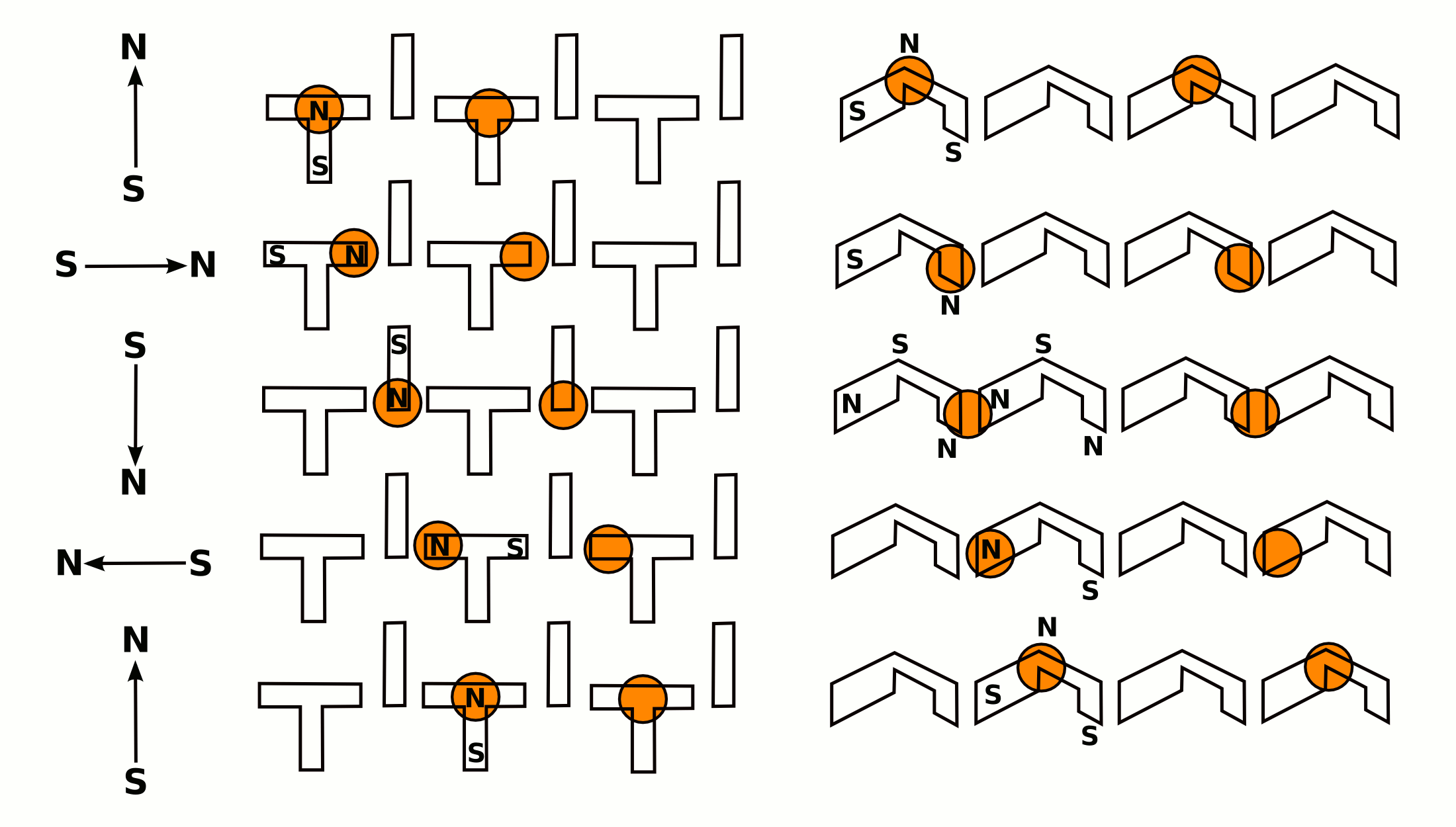Droplet Logic
September 19, 2012
Early in my career, I worked with
magnetic bubble materials. Magnetic bubbles are cylindrical
magnetic domains in thin
magnetic films. When viewed using
polarized light, they look like
bubbles in these transparent films, so the name stuck. Magnetic bubbles were used in
memory devices in the late 1970s through the 1980s, at which time
semiconductor memory matched the per-
bit price of bubble memory devices, and bubble memory devices lost their niche.[1-4]
Bubble memories were
serial memory devices. They worked like
tape drives, shuttling the bubbles around the magnetic film, through bubble generators (writing), bubble annihilators (erasure), and bubble detectors (reading). Bubble memory devices worked at a much higher speed than tape drives, and they were much more reliable, since they had no moving parts.
The figure below shows how an
in-plane rotating magnetic field, provided by
orthogonal coils, magnetized selected areas of a
permalloy pattern to move bubbles in a circuit. The operation of the leftmost pattern, called a T-bar pattern, is conceptually easier to see. The
asymmetric chevron, as shown on the right, works at higher speed, so it was used in commercial devices.

Two magnetic bubble circuits, the T-bar (left) and asymmetrical chevron (right). The permalloy pattern is magnetized in different states by an in-plane rotating magnetic field, and the bubbles are drawn towards the north-most pole. Diagram by author, rendered using Inkscape. (Click for larger image).
Magnetic bubbles repel each other, just as bar magnets do when their
magnetic vectors (N-S directions) are aligned. This repulsive effect can be used to make some simple
logic gates. You can have a bubble running along a track diverted to another track by the presence of another bubble.
Bubble logic was demonstrated for
AND,
OR,
Exclusive-OR,
NAND and
NOR operations.[5-6] This was more of a
laboratory curiosity at the time, but the idea has been resurrected forty years later in recent work on
water droplets moving on
superhydrophobic surfaces.[7-8]
Researchers in the
Department of Applied Physics,
Aalto University, Finland, (formerly the Helsinki University of Technology), and the
Department of Electrical Engineering,
Linköping University (Linköping, Sweden) have made use of the observation that water droplets sliding on a superhydrophobic surface bounce off each other, like
billiard balls. They were able to build logic gates, and even a
flip-flop, using droplets moving on superhydrophobic tracks.[7-9]

A logic gate (NOT/FANOUT) implemented using colliding droplets. The droplet at 1 would continue to A-bar if no other droplets were in the circuit. Collision with the synchronized droplet at A shuttles the droplet to track A, while the original A droplet continues unchanged. (Still images from a YouTube video)
The superhydrophobic surface was a
copper sheet,
silver-coated, and then covered with a
fluorinated compound. The research team had previously developed superhydrophobic tracks, which allowed guiding individual droplets.
Also demonstrated was a process for
programmable chemical reaction in which the water droplets contained reactive
chemicals. Logical operations were then employed to react certain droplets with selected droplets.[7] As a demonstration of this technique, the
fluorescence of
metal nanoclusters was quenched by a reaction.[8]
Says
Henrikki Mertaniemi, who discovered the rebounding droplet collisions two years ago,
"I was surprised that such rebounding collisions between two droplets were never reported before, as it indeed is an easily accessible phenomenon: I conducted some of the early experiments on water-repellent plant leaves from my mother's garden..."[7]
The expression, "
kitchen chemistry," is used to describe simple experiments that can be conducted in a
kitchen. This moves beyond kitchen chemistry to
garden chemistry.
References:
- A.H. Bobeck, "Properties and Device Applications of Magnetic Domains in Orthoferrites," The Bell System Technical Journal, vol, XLVI, no. 8 (October, 1967).
- Andrew H. Bobeck and H.E.D. Scovil, "Magnetic Bubbles," Scientific American, vol. 224, no. 6 (June, 1971), pp. 78–91.
- Alan B. Smith, Bubble-Domain Memory Devices, Artech House, Inc., 1974.
- Hsu Chang, Magnetic Bubble Technology, IEEE Press, 1975.
- R.M. Sandfort and E.R. Burke, "Logic Functions for Magnetic Bubble Devices," IEEE Trans. Magnetics, vol. MAG-7, no. 3 (September, 1971), pp. 358-360.
- Andrew H. Bobeck, Henry E.D. Scovil and William Shockley, "Magnetic Logic Arrangement," US Patent No. 3,541,522, November 17, 1970.
- Towards computing with water droplets – superhydrophobic droplet logic, Aalto University (Finland) Press Release, September 6, 2012.
- Henrikki Mertaniemi, Robert Forchheimer, Olli Ikkala and Robin H. A. Ras, "Rebounding Droplet-Droplet Collisions on Superhydrophobic Surfaces: from the Phenomenon to Droplet Logic," Advanced Materials, vol. 24, no. 35 (2012), DOI: 10.1002/adma.201202980.
- Superhydrophobic droplet logic, YouTube video Playlist, September 4, 2012.
Permanent Link to this article
Linked Keywords: Magnetic bubble; yttrium iron garnet; magnetic domain; magnetism; magnetic; polarization; polarized light; bubble; computer data storage; memory device; semiconductor memory; bit; serial; tape drive; in-plane; rotating magnetic field; orthogonal; solenoid; coil; permalloy; asymmetry; asymmetric; chevron; Inkscape; bar magnet; magnetization; magnetic vector; logic gate; AND; OR; Exclusive-OR; NAND; NOR; laboratory; water; droplet; superhydrophobic; Department of Applied Physics; Aalto University, Finland; Department of Electrical Engineering; Linköping University (Linköping, Sweden); billiard ball; flip-flop; NOT; YouTube video; copper; silver; fluorine; fluorinated; chemical compound; program; programmable; chemical reaction; fluorescence; metal; nanoparticle; nanocluster; Henrikki Mertaniemi; kitchen chemistry; kitchen; garden; Andrew H. Bobeck; Henry E.D. Scovil; William Shockley; US Patent No. 3,541,522.